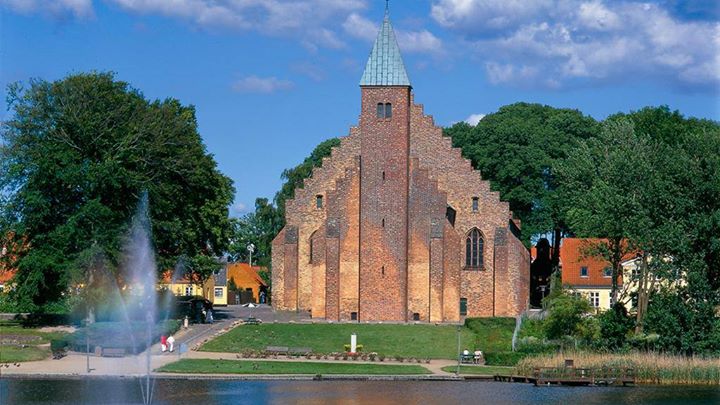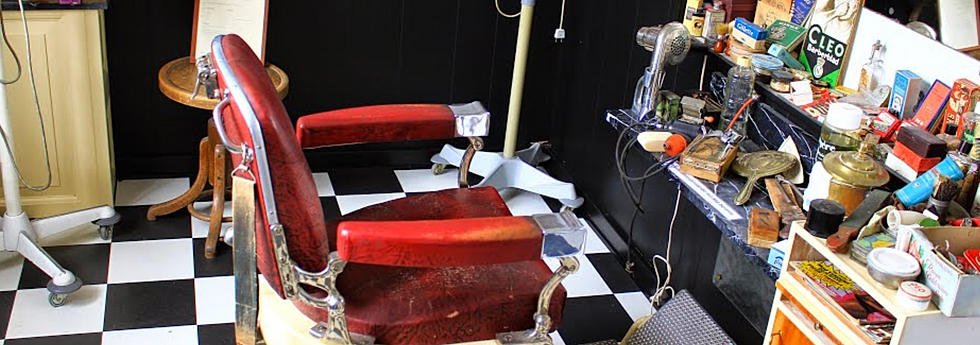Funen, Zealand & the Islands Aug 22-26 2018
Day 9
FUNEN ISLAND
This island with 470,000 citizens sits between Jutland and Zealand. Odense is famous as the birthplace of Hans Christian Anderson.
Aarup Mölle. Another windmill in the Nomad Mania “windmill” series, is about halfway between Vejle and Odense. It has a stone base, green shingles, and a black cap. It was closed and appears it is not possible to visit as there were no signs or information available.
ODENSE (pop 173,000)
The capital of Funen and one of Denmark’s largest cities, it has a lovely core just north of a stream surrounded by parks.
Kunstbygningen Filosoffen. This art gallery (everything has a price and is for sale) SW of the centre, has many nice pieces – I especially liked the bronzes by Pere Sala. Free
Brandts. This sprawling art centre in a converted textile mill is Odense’s premier art gallery. The permanent collection traces 250 years of Danish art from classic to modern and has a good section on international photography. The 3rd floor has a history of Danish media primarily in Danish. DK125
Jernbanemuseet. The Danish Train Museum has a well-done display of 10 locomotives and several passenger cars – the most interesting was the Interliner with a great display on backpacking through Europe with many testimonials. The Royal Saloon car of King Christian IX was beautiful. The museum is located behind the train station. DK100
Møntergården. This museum on Funen history is an eclectic display in seemingly random order. I didn’t find it so interesting. DK100
Hans Christian Anderson Hus. (1805-75) This small house sits in the miniaturized streets of the old poor quarter. Wander through the tiny rooms that give his family history (his mother was an alcoholic who died of delirium tremens). His achievements are put into an interesting historical context. One display is his height – he was a full 25 cm taller than the national average at the time. DK125
There is also a large museum on HC Anderson nearby in the previous Carl Nielsen Museet (a Danish composer) attached to the opera house. This whole section of Odense is a massive construction project including a new HC Anderson museum under construction set amongst a park of hedges.
St Canute’s Church. This church serves as both the parish church and the cathedral of the Funen diocese. In 1086, King Knud (Canute) was slain during a peasant revolt along with his brother Benedikt and 17 retainers in the nearby Church of St Alban’s. In 1100, he was then canonized, the first saint in Denmark. Benedictine monks from England built a travertine church, the only remains can be seen in the crypt. The present Gothic building dates to about 1300 with multiple extensions that now make it 62m long and a 20m high nave. There is a 1620bronze/brass baptismal font and the highlight 1523 altarpiece, one of the most beautiful medieval works of art in Denmark. 16 side panels surround a large Christ on the cross surrounded by many saints, all 23-carat gold leaf. The crypt contains the tombstones of Danish kings and queens from 1455-1559 and two famous reliquaries containing the exposed skeletal remains of King Knut and Benedict. Next to the casket it the 1100 silk Eagle tapestry. Free
Bunker Museum Odense. In a neighbourhood about 3kms SE from the city centre, this large WWII German bunker sits under the cover of plants. DK50
Day 10
NYBORG
Funen is connected at Nyborg to Zealand by the Storebælts Forbindlesen (Great Belt Bridge), an impressive 18km span. There is a costly toll each way: small/medium/large car DK 125/235/360.
Nyborg Castle. This castle was the ancient seat of the Royal Court until Nyborg was transformed in the last years of the 17th century into a fortified garrison town. The fortifications were removed in 1861 and the castle is presently in the process of being totally restored to what it looked like in 1850. It was completely covered in scaffolding but I walked along the high embankment to a round tower with cannon on the bank.

EGESKOV SLOT
Originally built as a fortification in 1554, it has been owned by the Ahlefeldt-Laurvig-Bille family since 1784. In 1883, it was restored with tower roofs and crenellated gables as a mix of Gothic and Renaissance architecture. The slot sits on massive oak pilings in the middle of a lake so is entirely moated. It is a living house and home for the same family – Count Michael Ahlefeldt smiles at you as you enter the grounds. In the late 90s, it was converted from a primarily agricultural enterprise into a tourist mecca. The castle exteriors are the best features as the interior is heavily Victorian in its furnishings and hunting trophies of now-rare animals. Cross the moat to a small guardhouse full of women’s fashion, accessories for both men and women and the clothing worn by all the servants of the house. It is UNESCO World Heritage-listed.
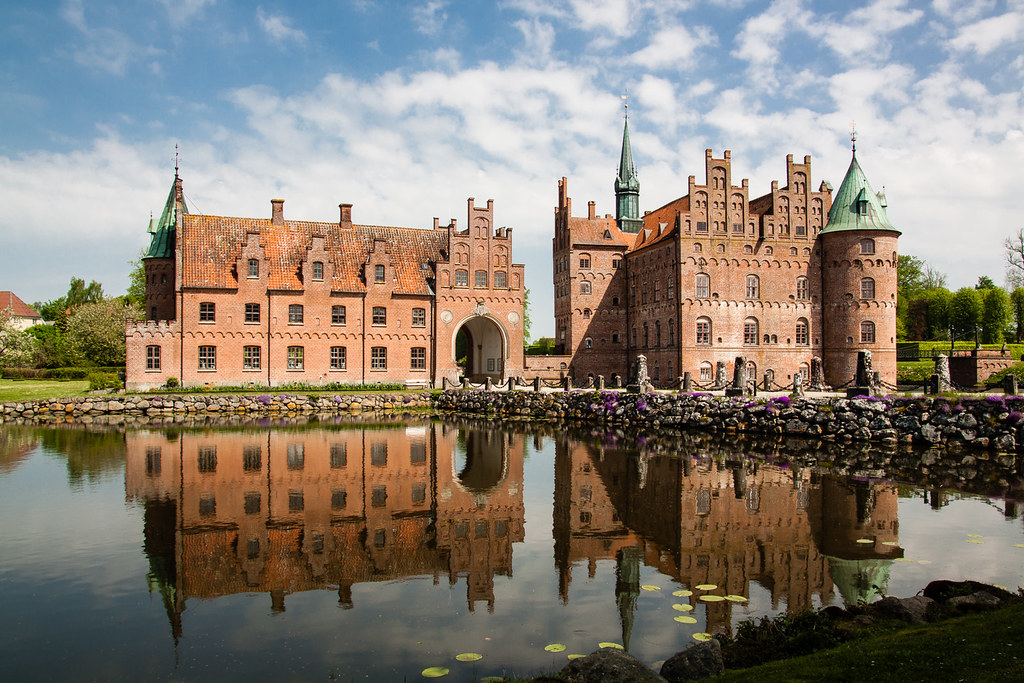
The castle’s expansive 15-hectare park has at least 12 gardens most surrounded by 4m hedges. The entire estate is a sculpture park with pieces randomly spread around, especially in the gardens.
The west side of the estate is a handful of first-class museums: vehicles from 1890-1910 and classic cars to the 70s including Cadillacs, a 1955 Buick, Rolls Royce, Aston Martin, Thunderbird and many others including a fighter jet are in two separate buildings. Another has many motorcycles. One of the most entertaining was an old store packed with old products. Falck, a Danish company that supplies emergency services throughout Denmark occupies another hangar.

Egeskov is SE of Odense about 2kms west of the small town of Kværndrup. Buses run from Faaborg.
DK220 for the house and gardens, 190 for everything but the castle.
FAABORG (pop 7200)
In its 17th-century heyday, Faaborg had one of the country’s largest commercial fishing fleets. Ferries leave here for Ærø Island.
Grubbe Mölle. A waterwheel has been here since 1599 and still operates today. The 1892 windmill operated until 1980. A hurricane destroyed it in 1899 but it was rebuilt. It is a black shingle with a black cap sitting on a massive stone foundation.
SVENDBORG (pop 27,000)
This town is the darling of the Danish yachting fraternity – it is a major sailing and kayaking centre. There are more Danish boats registered here than anywhere else beyond Copenhagen. It serves as the gateway to Funen’s beautiful southern islands. Although predominately a modern industrial town, it has some old buildings and a harbour packed with old wooden boats from across the Baltic.
Futurama. This natural history museum has 3 floors focusing on water, land, and air stuffed animals, all of which I have seen. Whale skeletons are in the basement. Lighting, sounds and films change the atmosphere of each room. There was also an exhibit on Microsculpture – The Insect Photography of Leven Biss from the collections of the Oxford University Museum of Natural History. DK140
Anne Hvides House. Anne Hvilde came from a well-off family and built this half-timbered house in 1554, making it the oldest house on Funen. It had many owners over the years and functioned as a hotel for 30 years until 1867. As recently as 2013, it functioned as a museum for the city of Svendborg but has been closed since. There are no signs on the building and I asked two local residents including the owner of the restaurant next door where the house was – nobody had ever heard of it. I had to Google it and get a picture to make sure I had come to the place Google Maps brought me to.

TÅSINGE ISLAND (pop 13,500)
Just over the bridge from Svendborg, its main village is Troense. Most of the rest of the island is agricultural and forest.
Valdemar’s Slot. This palace was built in 1639-44 by King Christian IV for his 17-year-old son Valdemar. Valdemar never really spent any time here as he preferred to fight wars and was killed in battle at age 34. It was awarded to naval hero Admiral Niels Juel and is used in the summer by his descendants who normally live in London. It sits on the water on the SW corner of Tåsinge.
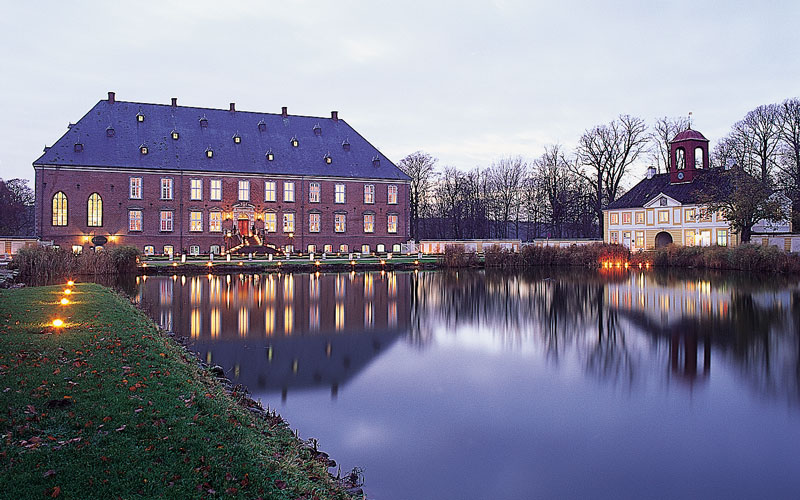
The palatial interior is jammed with furniture and eccentricities: lavish Venetian glass, 17th-century tapestries, and a secret ammo store. Rooms include the King’s Room, 1780 dining room, empress bedroom, library with 5000 books, chapel bedroom with 4-poster beds, a gallery with 6.5m ceilings, and Great Hall (most recently used as a badminton court prior to restoration). The attic has big game trophies collected by hunter Børge Hinsch. On the grounds are mini-golf and mountain bike riding. DK105

The M/S Helge, a vintage boat that ferries passengers from Svendborg, makes 5 stops (Svendbor Sund campground on the north tip of Tåsinge, Christiansminde beach, Troense and Valdemars before turning around.
ÆRØ ISLAND (pop 6800)
Located in the south of Funen Archipelago, it is reachable only by ferry. 90 sq. km in area, it is 30kms long and up to 9kms wide. The towns of Marstal (south end), Ærøskøbing (east side about ⅔ way down), and Søby are home to the majority of the 6,200 islanders. The climate is unusually mild with more sunshine hours than anywhere else. The island runs almost entirely on sustainable energy such as wind and solar.
Ferries: The island is served by 3 ferries: From south Jutland – Fynshav on Als Island to Søby (70 minutes), and from Funen – Fåborg to Søby (60 minutes) and from Svendborg to Ærøskøbing (75 minutes). The ferry had free, fast Wi-Fi.
Buses: The public buses running between all three towns and passing through most villages is free. Catch from in front of the harbour at Ærøskøbing on the half-hour.
MARSTAL. The largest town was once one of Denmark’s biggest maritime centres, second only to Copenhagen. Shipping is still the lifeblood. It is a modern-looking town with busy shopping streets. The Maritime Academy educates and trains navigators for the Danish merchant fleet. The 1738 church has blue pews.
SØBY. On the north tip of the island, it is home to the island’s fishing fleet and shipyard. The harbour has a lighthouse and a modern marina. The 1745 church on the top of the hill shapes the town and the 1881 windmill is the landmark of the town.
ÆRØSKØBING (pop 930). This is Denmark’s most well-preserved town from the 18th century dating back to the Middle Ages. It was a market town with shipping and trade supplemented by the farms inland. It is described as a Fairy-Tale Town with cobble streets, hollyhocks, climbing roses, and small well-preserved houses. In 2002 it was awarded the Europa Nostra prize for the preservation of European Cultural Heritage. The inhabitants make a concerted effort to preserve the town as it was.
I took the ferry from Svendborg to Ærøskøbing at 16:05 (departs hourly except at 18:05) for DK82 return and wandered around the small harbour and through the cobbled streets – a collection of old, quaint houses, restaurants, and stores. The hollyhocks had all finished blooming and were dried stalks. I ate my first meal out of the van on Ærø – flæskesteg (fish cake) with fries while waiting for the ferry and then returned on the 19:35 ferry.
Day 11
LANGELAND ISLAND (pop 13,300)
This long, narrow island is a major grain producer (isn’t all of Denmark?). From Funen take the bridge to Tåsinge Island and then another bridge to Langeland. A popular holiday destination of Danes, it has sandy beaches, cycling, and bird-watching especially at Dovns Klint where a large part of the island has been protected as a wildlife reserve. The main town is Rudkøbing.
Maderup Mølle. Supposedly near Odense, Google Maps showed it to be on Langeland very close to Rudkøbing, but then it took me to a suburb with no mill. Who knows where it is or if a windmill still exists?
Instead of taking the Storebælts Forbindlesen (Great Belt Bridge, an impressive 18km span with a costly toll each way – small/medium/large car DK 125/235/360) from Nyborg to Zealand, I took the more costly ferry (DK265) from Spodsberg on Langeland 45-minutes to Lolland Island and the South Islands of Zealand.
LOLLAND ISLAND
Maderup Mølle. This was impossible to find on Google Maps which took me to a rural neighbourhood. I didn’t bother entering the private properties looking for an old foundation.
MARIBO. I find the NM “small town” series always a mystery as I rarely have any idea what is special about each small town. Sometimes there is not much to see but Maribo was a special treat. Full of an incredible variety of old houses on the main street, I parked next to the square – there was a lovely fountain with a nude (with great breasts) holding a bowl of fruit and standing on a fish in the middle of the fountain.
The highlight though was the dark red brick, 1416 Domkirke with a wide, stepped façade. The whitewashed inside was spacious and full of light because of the wide, high-pointed arches separating the aisles from the nave.
The highlight was the gilded pulpit and 1641 carved altar full of angels, saints, and an outstanding last supper all with gilded hair and beards.

There were many grave slabs on the floor dating to the late 16th and 17th centuries. The south end of the church with its copper spire sits just above a lake.
Significantly, Maribo and the church are where the two great Danish pilgrimages cross. Both start at Helsingor in the NE of Zealand and take slightly different routes south. The Danish Monastery Route ends on the west coast of Lolland and the Santiago Route ends on the mid-south coast of the island.
Knuthenborg Safari Park. In a rural area 6 km north of Maribo, this park has African animals separated into areas: Limpopo Land, Congo, Savanna, and houses with tigers and other tropical critters. Having seen all these animals in natural habitats in Africa, I found it a waste of money, but for those who haven’t travelled, especially children, it could be quite enjoyable. DK220.
Fuglsang Kunstmuseum. Out in the countryside, this art museum highlighted a wide selection of Danish artists from 1860-1960: P Skovgaard, Ring, Dalsgaard, Ancher, Jorn and Mortensen. DK75
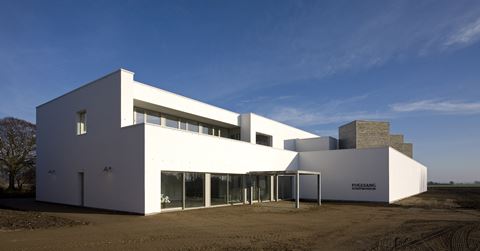
FALSTER ISLAND
Middelaldercentret (The Middle Ages Museum). Nykøbing. Starting in 1989, it took 8 years to completely construct this fictional medieval (1408) market town featuring live actors in period dress, role-playing as traders, craftsmen, and town folk. It shows how things are made in carpentry, amulet, weaving, dyer, shoemaker, rope maker, and blacksmith’s shops. There’s a medieval inn, herb garden, vegetable garden, orchard, animal pen, pigsty, brewery, and a harbour with boathouses and ships. Demonstrations on archery, war machines (trebuchets), and jousting occur at published intervals, but one would have to be here for 4 hours to see them all. A church is being constructed.
I found it not very interesting and much more suitable for children. Only Danish is spoken so it is hard to appreciate the full program. DK130.
Majbølle Mølle. Again this has not been operational for decades. Visits can be arranged by calling 54770332 or 48171272. But all windmills are the same.
MØN ISLAND
Møn Klint. These 126m-high white-chalk cliffs extend for 6kms along the east coast of Møn Island. They formed 70 million years ago in the Cretaceous Period and were subsequently compressed during the 5 glacial periods that involved Denmark (demonstrated by the folded layers of flint that traverse the chalk; the chalk itself is only about 60m thick). They are renowned for their fossils of sea creatures, especially belemnites, ⅔ of which have since disappeared but many are still present on Earth. There are amazing examples of urchins, starfish, and even crustaceans in the Møn GeoCentre. There was an interesting video on ALMA, a giant radio telescope. Don’t bother walking the boardwalk along the top of the cliffs as it is only in beech forest and the cliffs can’t be seen. Instead, take the 500 stairs down to the cobble beach for the best views. DK35 to park. GeoCentre free

STEGE. This 750-year-old town had a large herring fishery in the Middle Ages.
Thorsvang Denmark Sampler Museum (Collector Museum) in Stege. Henrik Hjortkær started collecting when he was 8-years-old (b. 1960).

He was a megalomaniac and amassed an amazing variety of stuff including 4896 unopened bottles of beer that fill a large wall. There are examples of food, pharmaceuticals, signs, magazines, books, and anything you can think of.
He also has recreated shops and workshops – a barbershop, blacksmiths, and out front 3 carousel rides. DK60
Burial Mounds. Western Møn has several Stone Age burial mounds: Klekkendehøj, Gronsalen (100m long dolmen surrounded by 145 large stones), Hong Asgers Høj (13m long burial chamber), Jordehøj (10mx2.5m chamber), and Soarkedyssen (octagonal chamber with a large stone on top), many of which have passageways and chambers that can be visited.
Frescoes. Elnekybdem, Fanefjord, and Keldby Churches all have 15th-century restored frescoes of bible scenes and everyday life.
Bridge Walking. In the NM “Experiences” series is bridge walking. There are an amazing number of great bridges crossing the many channels separating all the islands in South Zealand. Walking paths are narrow on the primary car bridges.
BOGØ ISLAND
Bogø Mølle. This windmill is actually kind of pretty – a big stone base and a second floor of red and white plaster. Built-in 1852, it has not been operational since 1965 and visits are sparsely available – I was there on Aug 24 and the next tour was on September 16th
ZEALAND ISLAND
Skibsmotor Museum in Rødvig. This is one of the more unusual museums on the Nomad Mania list and one I certainly would not have visited otherwise – it might be of interest to a few from a nautical interest. There are model ships, brass plaques from ships, pulleys, lights, and all sorts of minor ship memorabilia, but the showcase is the amazing number of ship motors all mounted on wood pallets, each with a sign showing its specifications (if anyone cared) and all in Danish. DK40
STEVNS KLINT
Fish Clay. This is a UNESCO World Heritage site (2014) because an American geologist in 1978 discovered the “fish clay” layer. It is one of the best places to see evidence of the layer of ash that darkened the skies and was deposited over most of the earth 65.5 million years ago when a giant asteroid hit the Yucatan Peninsula in Mexico. It caused the extinction of the dinosaurs and half of all other species on Earth. The layer is difficult to see and it took me some time to figure out after reading all the dioramas along the clifftop.
Take the very steep metal stairs to the beach. Don’t bother climbing up the wooden stairs and rough path as it is much easier to boulder hop along the beach. Above the cobble beach is a large white cliff with many bands of dark flint running horizontally across it. The bottom of the cliff is soft chalk and above is hard limestone often forming an overhang (called yellow limestone but looked quite white to me) about halfway up. The fish clay is a very narrow, 5-10cm deep layer of grey material that almost requires imagination to make out immediately under the hard limestone and the overhang. It is rather underwhelming. The flint layers are much more dominant and interesting. It is legal to collect fossils from the beach. The museum was closed when I arrived late in the day. DK40 for parking.
Hejerup Kirke. This 1200-era church became famous in 1928 when the cliff under it collapsed and the choir fell onto the beach and ocean.
The church is open till 19:00 most days. Walk out onto the balcony supported on a sturdy cement wall that looks straight down the cliff.
Inside are the hymn boards, a disintegrating triptych (looks like it was recovered from the beach), and pulpit, fading frescoes, and simple pews.
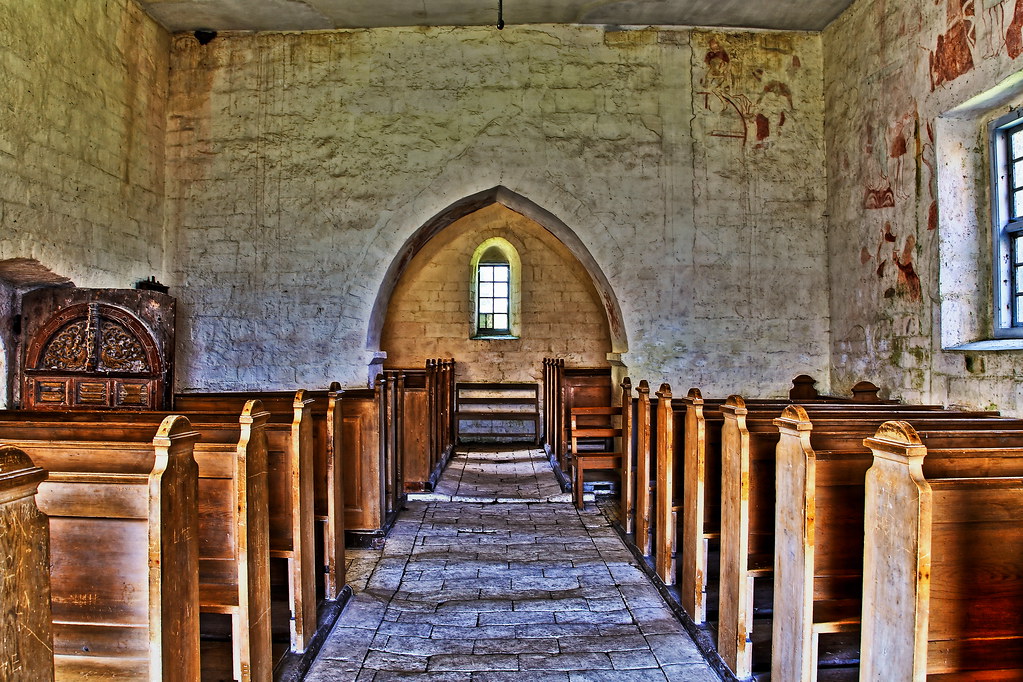
Parish Church. Sitting away from this cliff is the present parish church. Like all Danish churches, it has a lovely graveyard. It is a memorial to 7 RAF crew members whose Halifax plane was shot down off the coast in 1943. They were on a Special Operations flight from England to Poland to drop 6 containers and 6 packages to the Polish resistance. All 7 bodies washed up onshore and are buried across some graveyards along the Danish coast (and one in Sweden).
Cold War History. Stevns Klint and the area played a crucial role in Denmark and NATO during the Cold War with a large radar installation.
I slept at a lovely quiet layby. Thrown out next to the garbage can were two perfectly good badminton rackets including an expensive one with a graphite shaft. Badminton is very popular in Denmark and it routinely produces world-class players. I saw several at the World Finals in Dubai in 2106.
Day 12
Næstvig Kunstfornig. This photographic museum had some lovely photographs using double exposures by Josephine Ernst. There are several branches of this municipal museum but this is the one I found next to the church. DK40
SLAGELSE
Panzer Museum East. About 15 km SE of Slagelse in the countryside, this military museum shows the tanks, artillery, and armoured vehicles the Russians would have attacked us with during the Cold War (1947-91). 99% is made in Russia or Czechoslovakia from the 60s and 70s and collected by a military obsessive. There are field hospitals, field bakeries, propaganda vans, and other specialized vehicles and equipment. A special attraction is the near-complete KRUG missile system with the P-40 radar vehicle (thank god it is not complete). All the employees are dressed in uniform. It is possible to take safaris on big military trucks. The shop has everything you ever wanted in a camo design. DK95
Slagelse Museum. There are three main exhibits here – a 1940-50s store full of products our grandparents would recognize, the industry of Slagelse (primarily candy), and a street from the 1800s. DK30
TRELLEBORG FORTRESSES
The Trelleborg fortresses include Trelleborg, 7kms NW of Slagelse, Fyrkat near Hobro, Aggersborg near Løgstør and Nonnebakken in Odense, of which only the first three are preserved today.
They were built as military fortresses around 980 by King Harald Bluetooth (930-987) in his efforts to unify his kingdom of Denmark, southern Sweden, north Germany, and parts of Norway and introduce Christianity to Denmark.
The fortresses probably lasted only 10 to 20 years. Harald was succeeded by his son, Swein Forkbeard (960-1014) who had better control of the kingdom and political alliances with the Slavic countries, the south Baltic Sea area, and the Norman duke in north France. Sweden also invaded England. Thus there was little need for the fortresses. Swein was succeeded by Harald II and then by his second son, Knuth the Great (995-1035) who finished the conquest of England in 1016 and ascended the throne in 1019. Fyrkat was destroyed by fire and was not rebuilt. Despite this, the fortresses are viewed as a significant military manifestation of the central power of the late Viking era.
All the fortresses are built in strategic locations in river valleys close to the coast and on Viking period junctions. The architecture of all four ring fortresses was uniform and the same size and layout – a moat, a circular outer rampart constructed of heavy oak palisades on both sides (the outer oak wall was 8m high) connected by beams and filled with stone and clay. There was one entrance on the south and 15 longhouses in this outer area. The inner fortress had a 136m inner diameter with a 17m wide moat and a 5m high rampart with four roofed gates at the four points of the compass. In this inner fortress was an asymmetrical, geometric street system with four blocks of four longhouses in each quadrant – 30m long, a gable room on each end, and a central room about 18m long with a central hearth. 8000 oak trees were used to make each fortress.
Trelleborg was built strategically on a headland between two rivers used for transport (there was evidence of occupation of the area for over 5000 years). The sea was only 3kms away. It also had a graveyard with 157 graves and three mass graves.
Today, the visible elements are only the embankments (now dirt) and entrances without woodwork or moats. At Fyrkat and Trelleborg the longhouses are outlined with rocks. Trelleborg has a beautifully reconstructed longhouse outside the embankments.
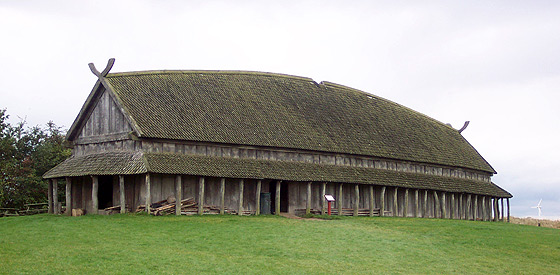
A museum gives an excellent description of the structure and history of the ring fortresses. At Aggersborg, the original embankments were levelled by plowing, but the rampart and the moat have been reconstructed.
The transnational project unites properties already appointed as Viking Age World Heritage with the newly nominated sites of Danevirke and Hedeby as well as GrobiĦa, the Danish fortresses, the Vestfold burial mounds, and Hyllestad quernstone quarry.
The Trelleborg fortresses cannot be viewed in isolation; they must be considered in a historical context that includes the Jelling burial mounds and nearby defences at Dannevirke, also constructed by Harald Bluetooth and his father, Gorm the Older. It is believed that the Trelleborg fortresses were of great significance in this respect.
Sorø. Another NM “small town”, the only redeeming feature here was the abbey church with its porch wall the only surviving remains of the medieval church and possibly part of the oldest residence in Denmark. The church supposedly has frescoes and wood carvings but was closed.
ROSKILDE
Viking Ships Museum. The king at the time, Svend Estidsen (1047-74) made an underwater barrier in the channel connecting Roskilde with the sea to prevent an invasion by enemy ships. The barrier was 20 km upstream at Skuldelev. There were 3 channels in the river and two were blocked using five ships all sunk at the same time. A third channel, much more sinuous and difficult to navigate was left open for access. These boats all had a life expectancy of about 30 years and may have been at the end of their useful lives. All five ships were recovered and placed in this excellent museum. Although some are almost completely disintegrated, iron frames are used to display the excavated parts. Also, all five ships were rebuilt and on display in the nearby harbour.
#1. This was a sturdy, ocean-going trading vessel originally built in Norway. It had decks fore and aft and was thought to have sailed in the North and Baltic Seas.
#2. This ocean-going warship was built in Dublin, Ireland in 1042 by Scandinavians who had settled there in about 800 AD as merchants, mercenaries and shipbuilders. With a crew of 65-70 using 60 oars, it was long and narrow and capable of speeds of 12 knots under sail. As a reconstruction called the Sea Stallion of Glendalough, it made many voyages in the North and Baltic Seas.
#3. This small trading ship was capable of carrying about 10 tons of cargo using
6-8 sailors. It had sails and oars.
#4. This was a fishing, whaling, and sealing boat made of pine in Sognfjord, Norway.
#5. This small warship had 30 warriors using 13 pairs of oars.
Rowboat cruises using 10m Viking-era boats are possible from the harbour (with the 10 guests in each boat providing the muscle power). DK100
Roskilde Domkirke. This twin-towered giant of a church is UNESCO World Heritage-listed. Originally a 1080 travertine cathedral, it was reconstructed with bricks starting in 1170 and finished 110 years later as a Gothic cathedral.
22 Danish Kings and 15 queens (almost all of them since 1413) are buried here in massive coffins. Many side chapels have been added over the years to accommodate them. The tombs and chapels were created by artists and architects who were the best of their day.

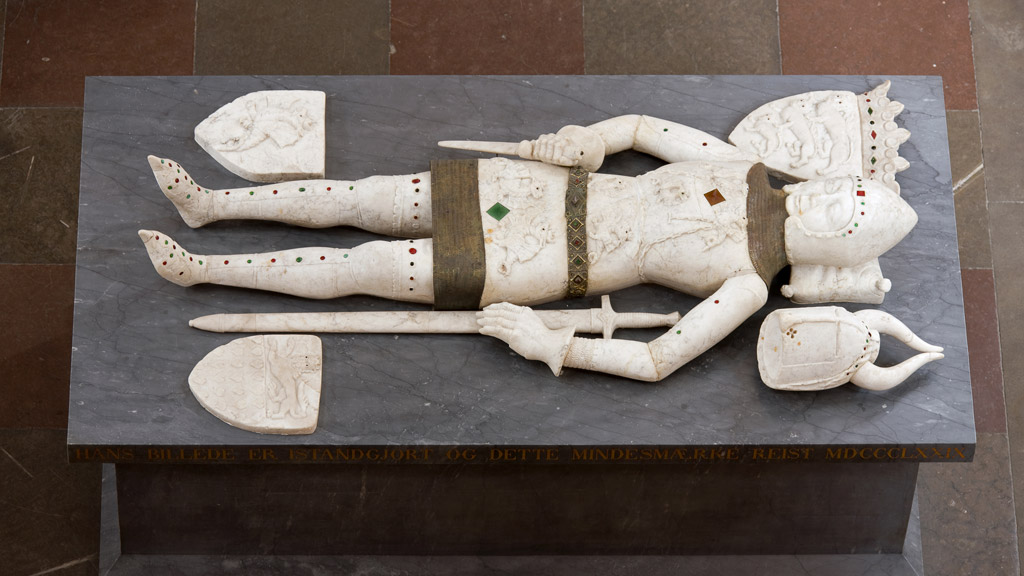

There is a large exhibit on the tomb constructed for the present queen, a glass masterpiece topped with a gilded construction and mounted on silver elephants on a marble base. It is under wraps and sitting in the church.

The altar is a magnificent multi-panelled triptych of the Ways of the Cross covered in gilt.
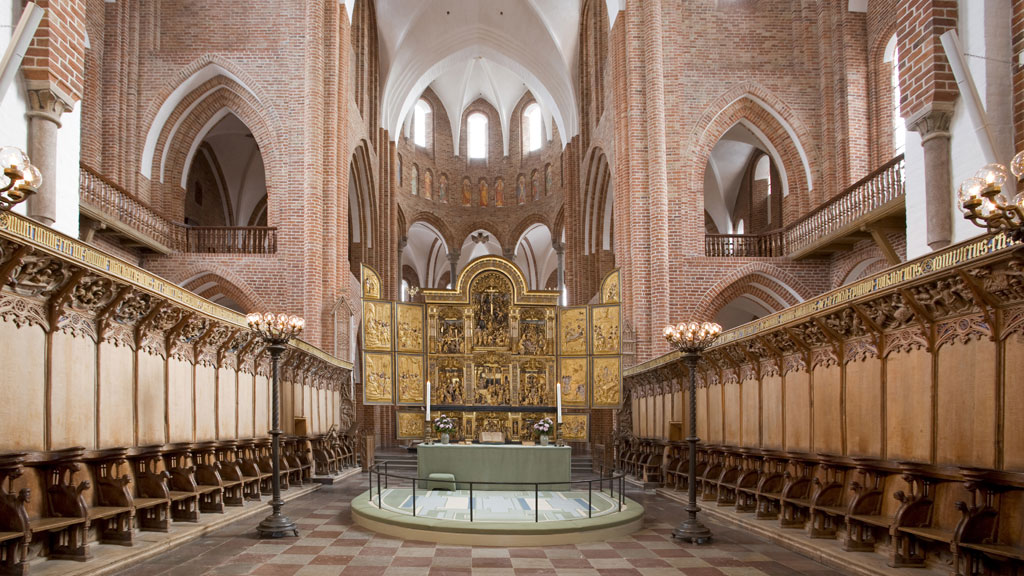
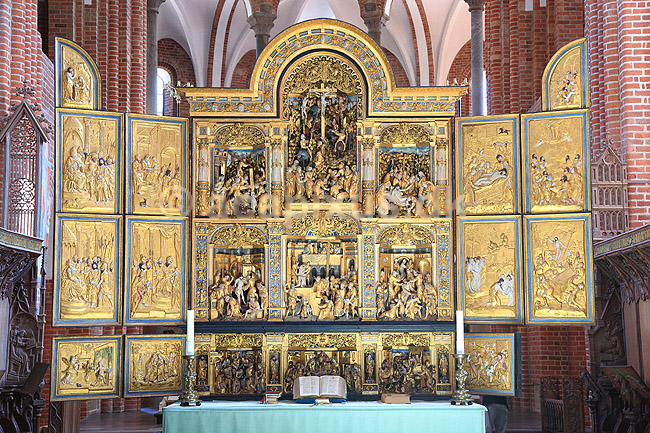
Walk around the second-floor gallery with Lego constructions of the periods of church construction. Peer down onto many of the elaborate coffins and see the museum all in Danish and mostly photos. DK60
Day 13
PAR FORCE HUNTING LANDSCAPE in NORTH ZEALAND
The Par force hunting landscape in North Zealand is a collection of hunting grounds, forests, and buildings north of Copenhagen, inscribed on the UNESCO List of World Heritage Sites in 2015.
Location. The three forests are all located in the North Zealand peninsula to the north of Copenhagen. Jægersborg Dyrehave with the fenced Jægersborg Hegn is closest to the capital on the peninsula’s east coast. The square-shaped Store Dyrehave is located further to the north in the centre of the peninsula while Gribskov, further north still, is adjacent to Esrum Sø. Store Dyrehave and Gribskov are not far from Frederiksborg Palace and the town of Hillerød.
Background. They form parts of a well-preserved Baroque hunting landscape designed in the late 17th and early 18th centuries for the Danish monarchs to participate in par force hunting. The area for hunting dates back to the Middle Ages when the Danish kings, the church and noblemen had estates and hunting grounds in the peninsula’s hilly forests and undulating farmlands. In connection with the Danish Reformation, in 1536 King Frederick II confiscated the estates belonging to the Catholic Church. From 1560, the various estates were merged to establish an extensive royal hunting park. King Christian V, from 1670 put his army to work on creating a par forced deer park around Ibstrup Castle. He imported hounds and huntsmen from England, renaming the castle Jægersbor (hunter’s castle) and the estate Jægersborg Dyrehave (Jægersborg deer park).
It demonstrated the absolute power of the monarch by developing connecting roads across the landscape. The entire North Zealand peninsula area was patterned with a Cartesian-based mathematical road system consisting of stars surrounded by distinct squares. Stone posts indicated whether roads led towards or away from the centre of the star. The Danish orthogonal geometry of the road systems was an improvement on the star-shaped grids used in France and Germany as it provided equal access to all parts of the forest.
The Jægersborg hunting park contains no star-shaped road networks but has a royal hunting lodge, rebuilt in 1736 in Baroque style as Ermitageslottet or the Hermitage Hunting Lodge, with a grand view over the surrounding landscape from its hilltop location.
The Danish Museum of Hunting and Forestry is devoted to the Par Force Hunting Landscape. Nearby is the Stevns Klint, a UNESCO heritage site in 2014.
Skjoldungernes Land. This national park occupies the area on the south end of Roskilde Fjord about 15 km NW of Roskilde.
Copenhagen Card. DK899 (120€) – 120 hours, 93€ – 72 hours, 77€ – 48 hours, 54€ – 24 hours. When I discovered it covered all the museums in North Zealand, I thought it would be a good deal. Covers 86 museums and attractions and unlimited travel on trains, buses, metro, and harbour busses through the entire capital region, including to Copenhagen Airport.
FREDERIKSBORG SLOT (The Museum of National History)
In Hillerød on the banks of Castle Lake, the oldest part dates from Frederic II’s time, though most of this Renaissance castle was built by Christian IV (1588-1648) at the beginning of the 17th century to signify his position as a powerful North European monarch. The castle was no longer a royal residence in the 18th century but was still used for official royal functions. Kings were anointed in the castle church during the period of the absolute monarch in Denmark (1660-1848) and a wave of national romanticism in the 19th century resulted in the castle becoming a national memorial.
A fire in 1859 destroyed most of the interior. The restoration was financed with national subscriptions and J C Jacobsen, founder of the Carlsberg brewing company. He proposed making the castle a Museum of National History, still operated and funded by Carlsberg. The museum dating from 1878 records 500 years of Danish history with paintings, portraits, furniture, and art.
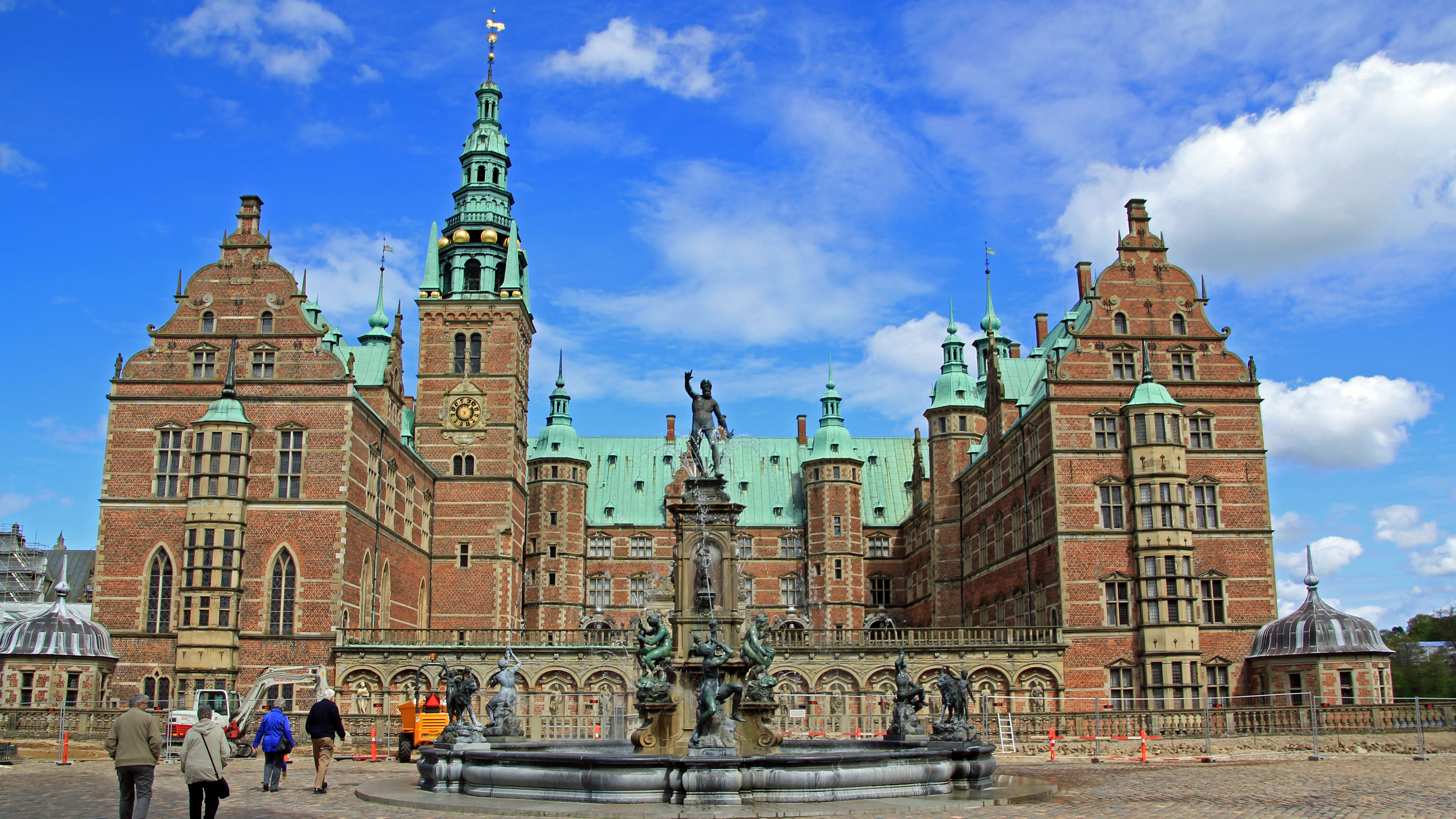
The interior is grand (think Versailles) with wood panelling and floors, fireplaces, over-the-top ceilings, coats of arms, paintings of everybody in Danish history, and tapestries remade after the fire.
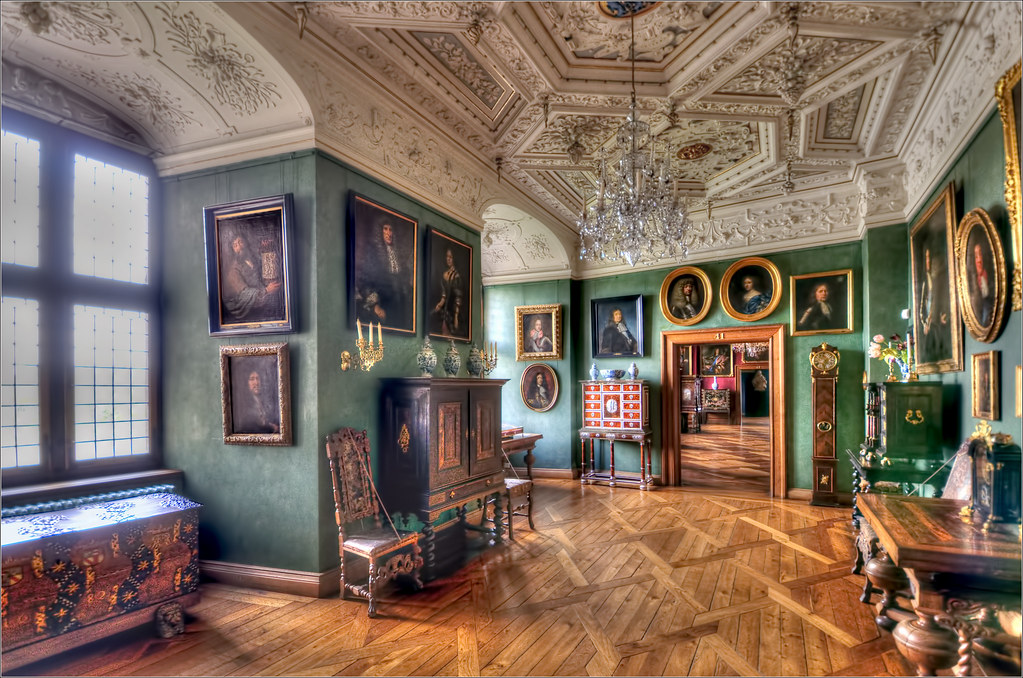

The 1610 church has a ceiling of angels in gilt and carved pew decoration. The shields of the knights of the Order of the Elephant and Order of Dannebrog cover the walls.
The Great Hall has changing exhibitions – the present one is on Frederic, the heir apparent who was educated at Harvard. The third is the National Portrait Gallery. Fixed tours are held on Sundays. DK75, 60 concession.
Fredensborg Palace. This is the royal couple’s most frequent residence during the spring and autumn months and it is only open to the public from July 1st to August 5th when they are not in residence. The original small white, elegant palace complex dates from 1720-29. It was named Fredensborg to commemorate the Great Northern War that ended in 1720. In the following decades, the palace was extended several times. Christian IX hosted royals from all over Europe here. He is known as the father-in-law of Europe as he married off his children to many European royal houses – Alexandra was married to Edward VII of England, Dagmar to Alexander III of Russia, and Vilhelm was crowned King of Greece as Georg I.
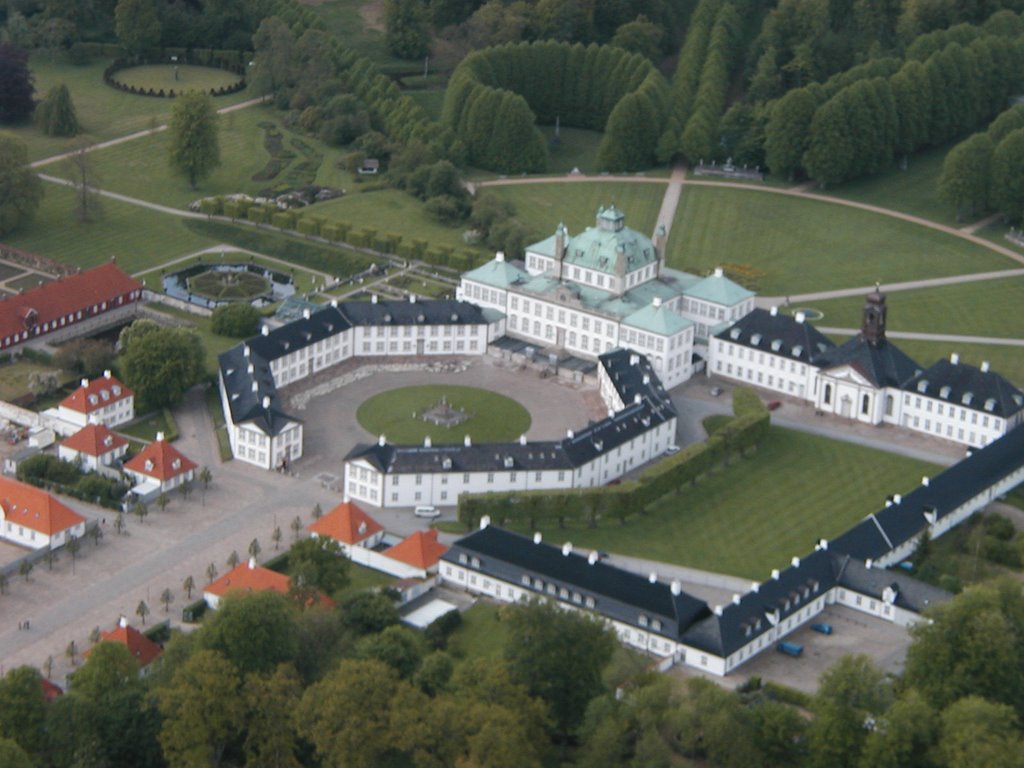
State leaders on official state visits are received here and royal events are hosted. Guided tours take you to the Dome Hall (the official dining room), the Garden Room, the Chapel, the Orangery, and the kitchen gardens. The Palace Gardens are French Baroque dating from the 1760s and a double avenue has 70 sandstone statues of Norwegian and Faroese farmers and fishermen. DK95
HELSINGØR (pop 47,000). This harbour town on the NE tip of Zealand is a common destination for Swedes who arrive by ferry to buy cheap booze and most others to see Kronborg.
KRONBERG CASTLE. At the strategic entrance to Øresund (Sweden is across the water), it initially was a tollhouse built in 1420 and was greatly expanded by Frederick II in 1585 to establish himself as the most powerful king in Scandinavia. It is UNESCO World Heritage-listed. It is protected by a double star-shaped moat and wall toward the land and the ocean at its back. A fire in 1629 destroyed almost everything but the chapel and outer walls and was rebuilt by Christian IV. After seeing the grandiose Frederiksborg Slot, the interior is very simple white with some massive wood-beamed ceilings.

The highlights are the furniture and fireplaces, the chapel, and the King’s tapestries from 1586. The Great Room is massive. DK140

Chapel
The castle has been the location of many Hamlet movies starring such greats as Laurence Olivier (1937), Christopher Plummer (1963), Richard Burton (1964), Michael Cain, Fu Xiru (2005), Jude Law (2009), and many more. There are frequent live recitals in the courtyard called Hamlet Live.
Hamlet. In the late 1500s, Shakespeare wrote his most famous drama which takes place at Kronborg Castle. A short synopsis of the play follows:
Hamlet meets the Ghost of his father in the deep passages under Kronberg. The spirit tells him that Hamlet’s uncle, Claudius, murdered him in his bed and incites Hamlet to take revenge. Confused and full of rage, Hamlet looks for evidence of Claudius’ guilt. Claudius, in the meantime, has been proclaimed King of Denmark and has married Hamlet’s mother, Queen Gertrude. Hamlet hatches a cunning plan pretending to be mad to buy time until he can exact his revenge. But the plan involves spurning his one true love, Ophelia, the daughter of Lord Chancellor Polonius. Tragically, he accidentally kills Polonius and Ophelia finally loses her mind to wander the corridors of Kronberg.
Laertes, Ophelia’s brother, and Hamlet’s best friend accuses Claudius of the murder, but the two of them eventually plot against Hamlet. He arranges for Hamlet to be struck down during a fencing tournament but things do not go exactly according to plan.
Yorrick, the court jester is Hamlet’s friend. He understands what is truly going on and his gossip needs to be listened to.
MARITIME MUSEUM OF DENMARK (Museet for Søfart). On the harbour next to Kronborg, this 2013 museum is in the shape of a huge ship underground. It tells the story of Denmark as one of the world’s great shipping nations. I especially enjoyed the exhibits on sailor culture.
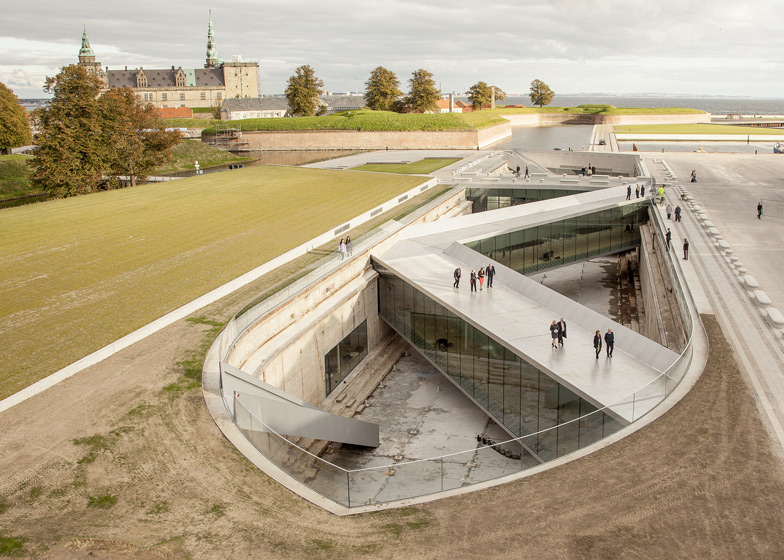


Helsinger Bymuseet (Helsingor Town Museum). In the small Carmelite Hospital from 1520here is a small exhibit on local history and a temporary exhibit featuring Simon Spies (1921-84), a famous Danish millionaire and businessman (Spies Travel agency and Conair promoted inexpensive package tours to sunny destinations) with a lavish and eccentric lifestyle (questioned norms and authority, experimented with psychedelic drugs, mysticism and long periods of silence and loved stunts for the media). Unfortunately, it was only in Danish. DK45
Elsinore Walk. This 800m walk follows the Helsingor harbour passing Kronborg Castle, the Maritime Museum, Kulturværftet library, and the cobbled streets of the old town centre.
Louisiana Museum of Modern Art. In the town of Humlebæk, about 25kms north of Copenhagen, the art is spread out amongst 4 galleries separated by a sculpture park. Danish artists (Asper Jorn ugh, Carl Pedersen, Robert Jacobsen, and Richard Mortensen) are supplemented by international artists (Andy Warhol, Picasso, Francis Bacon, and Robert Rauschenberg). Some of the sculptures (Henry Moore, Max Ernst) and temporary exhibits are in galleries and on the grounds. There was an exhibit on masculinity that was somewhat interesting. I was there on a Sunday and 3 talks were being given by authors and other artists. The place was packed with people, but I found the art not so interesting (like most modern art). DK125
Hørsholm Mølle. Another NM windmill, this one is only open from 10-1 over the summer. There was a small museum with farm tools and a smithy in the bottom of the mill and 2 separate buildings, one with exhibitions on manual crafts like shoemaking, sewing and carpentry. “Seen one, seen them all”. Free
KLAMPENBORG. This community is a suburb of north Copenhagen. Both the following are in the Nomad Mania “entertainment/things to do” series.
Breda Works. Part of the Denmark National Museum system, this museum showcases industrial culture. The museum is in an industrial area – at one time 17 watermills on the nearby river powered the Industrial Revolution of Denmark, mainly based on textiles. The communities were model towns set up by some of the industries with housing, schools, and social programs well ahead of their time. The museum is open only on weekends (10 am-5 pm) from May to mid-October. DK50
Bakken (Dyrehavsbakken). A huge amusement park, it charges for parking, gives free admission to the park, and then charges excessive prices for the attractions: 30 rides for older children, 11 rides for small children, 46 skill games (think carnival attractions), 5 casinos with slot machines, 25 restaurants, and 21 fast food outlets. I was surprised how many adults without children there were, but most were drinking beer. This is really a place for kids. DK289-189 depending on attractions desired.

